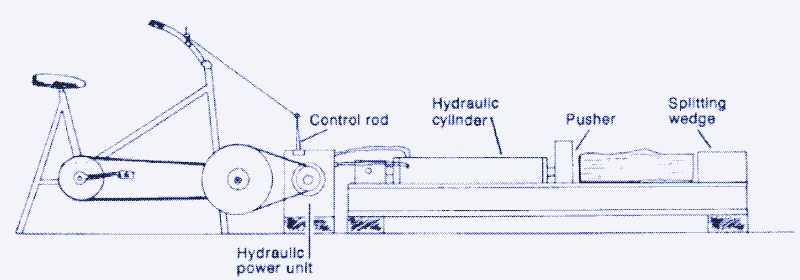
If we boost the research on pedal powered technology - trying to make up for seven decades of lost opportunities - and steer it in the right direction, pedals and cranks could make an important contribution to running a post-carbon society that maintains many of the comforts of a modern life. The possibilities of pedal power largely exceed the use of the bicycle.
One way to solve the large energy losses of pedal power generators is not to produce electricity at all but power devices mechanically, whenever possible. Another way - the only way for devices that cannot be powered via a direct mechanical connection because they do not rely on rotary motion - is to make the generation of electricity more efficient.
This can be done by building a pedal powered generator from scratch instead of using a road bicycle, or by ditching one or several electronic components in the power transmission chain. All approaches can be combined, resulting in a pedal power unit that can power a multitude of mechanical devices and generate electricity comparatively efficiently.
Direct Mechanical Power Transmission
Many machines could be powered by a direct mechanical connection, though it generally means adapting the device so that it can work independently of electricity. However, stationary pedal machines with direct mechanical power transmission – although they were common in the old days – are not available commercially in the western world.
The only exception seems to be the Fender Blender, a pedal powered machine used to make smoothies (picture on the right). However, old school bicycle machines are now being designed both by amateurs in the western world and non-profit organisations in the developing world.
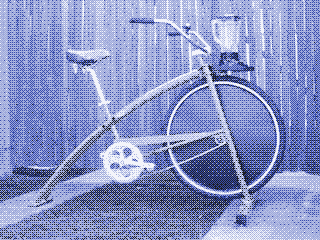
In Guatemala, Mayapedal has been building some 2,000 pedal powered machines from old bicycle parts since 2001. To date, the NGO has built pedal powered water pumps, grinders, threshers, tile makers, nut shellers, washing machines and blenders. These cost only $40 to $250 to make. Their contraptions have become more sophisticated and even cheaper to build over time, evolving from adapted bicycles to pedal powered machines built from scratch which incorporate a flywheel, and are capable of driving different types of appliances.
Another example is the VitaGoat Cycle Grinder developed by the Canadian NGO Malnutrition Matters. The pedal powered grinder forms part of a complete food processing system which is delivered to developing countries in Asia and Africa. Chocosol teaches local people in Mexico to build their own pedal powered cacao bean grinders and the Canadian promoters also use the technology in their shop in Toronto. The Full Belly Project designs human powered nut shellers for farmers in Africa.
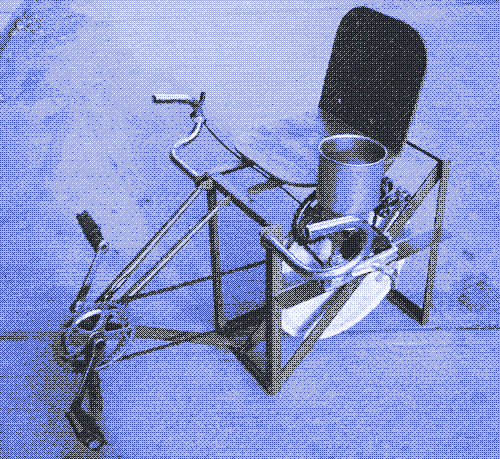
Then there are the many contraptions built by individuals too: the pedal powered washing machines by Alex Gadsden and Homeless Dave, the pedal powered soap blender by Frederick Breeden, or the pedal powered apple grinder by Ben Polito. Similar machines have also been built outside the US. Some have concentrated on restoring and putting to use antique machines, like Blue Ox Millworks.
One obvious disadvantage of designing a pedal powered machine for every application in the household, farm or workshop is that you need a lot of space. Furthermore, designing a pedal power unit for every tool might become labour-intensive, costly and energy-intensive.
This is not as much of a problem in cases of small-scale industrial use, where few machines are required in order to manufacture a product. A good example of this is the pedal powered soap blender mentioned above. For this reason, a pedal powered blender could be a realistic option for small businesses, such as a smoothie bar.
The design of universal pedal powered units with direct mechanical transmission was extensively researched in the 1970s
However, when more tools are needed and space is restricted, as is often the case, we need to find ways to get around this problem. One solution is to use pedal power to generate electricity which can then be used to power different devices. However, this approach is highly inefficient with energy losses of up to more than 70 percent and should be avoided whenever a device can be powered in a mechanical way.
Another solution is to design a universal pedal power unit with direct mechanical transmission that can be used to operate a large variety of different tools and devices (including a generator). This method, which solves both the space and inefficiency problem, was extensively researched in the 1970s.
Multi-purpose Pedal Powered Machines
Universal pedal powered machines did not exist at the turn of the twentieth century, although some combined a few functions (both sawing and drilling, for instance).
At least five interesting inventions were designed and built in the 1970s: the Energy Cycle (by Dirk Ott), the Dynapod (by Alex Weir), the Human Powered Flywheel Motor (by JP Modak), the Pedal Power Unit (by David Weightman) and the Dual-Purpose Bicycle (by Job Ebenezer). All these concepts are also of interest for the construction of single-purpose pedal power units.
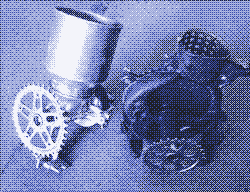
The Dynapod
After experimenting with single-purpose pedal powered machines in several countries in Africa, British engineer Alex Weir (who is also the promoter of this online low-tech database) built a multi-purpose ‘Dynapod’ (the name stemming from the Greek words for ‘power’ and ‘foot’) in Tanzania in the early 1970s. The power module, based on a 1968 concept by Stuart Wilson of Oxford University, came in a one-man and two-man version. The tandem unit doubled the power output, and at the same time evened out the power flow, with both sets of pedals placed out of phase.
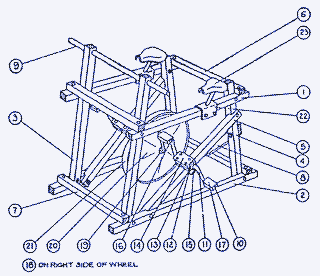
The Dynapod was made using a custom-built frame. Apart from pedals, cranks and chain drives, the machine shared nothing with a bicycle. The first designs used wooden frames, while later versions were based on a steel frame. For a flywheel, Weir used an old bicycle wheel filled with cement. The cost of the wooden frame unit (in 1980) was $40 to $100, materials and labour included.
The Dynapod could drive pumps, corn grinders, winnowing machines, forge blowers, grinding machines, drilling machines, potter’s wheels, paint sprayers, crop dusting equipment, cassave graters, coffee pulpers, grain hullers, fibre decorticators, threshers, balers, band saws, tire pumps and sewing machines. It could also be used to generate electricity.
Apart from pedals, cranks and chain drives, these human powered machines share nothing with a bicycle
To allow the operation of such a wide diversity of appliances, the Dynapod was equipped with multiple drives. It could be operated with a direct drive having a ratio of 1:1 (when a lot of torque was needed at a slow speed), a chain drive with a ratio of up to 3:1 (a compromise between torque and speed for operating grinders, threshers, etc.) or a belt drive with a ratio of up to 10:1 (for electrical generation, a winnowing fan, and other uses where high speeds were required). The machine was easily adapted from one drive to another. Multiple drives on pedal powered machines were not a novelty - some earlier pedal powered machines had them too.
The Energy Cycle
Rodale Press, the publisher of the 1977 book ‘Pedal Power in Work, Leisure and Transportation’ also had a research team - Rodale’s Research and Development Department. Together with inventor Dick Ott they conceived their version of a universal pedal power unit, the ‘Energy Cycle’.
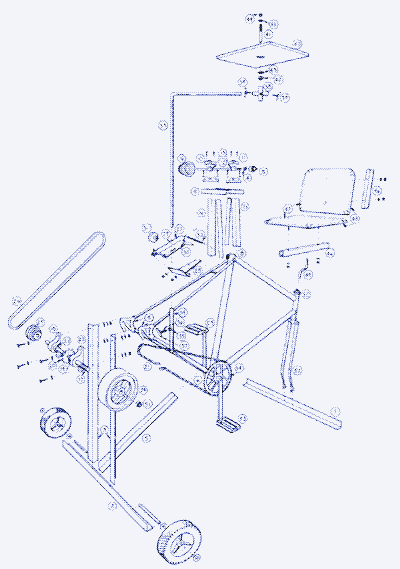
Just like the Dynapod, it was built from scratch and could accommodate a large number of detachable tools. These included kitchen aids (such as an egg beater, can opener, nut chopper, food grinder, fish skinner, meat and cheese slicer and a cherry pitter), farm machinery (including an irrigation water pump, feather plucker, potato digger, corn sheller, grain cleaner, rice polisher and oatmeal roller) and more general tools (like a wheel grinder, stone polisher, drill, wood carver and battery charger).
Several improved prototypes were built, first of iron, and then of steel. For the first upgrade of the design, a large work table was added to the unit which enabled the operator to perform numerous tasks without leaving his seat. Later versions were equipped with a flywheel.
Experiments showed that the unit offered considerable benefits in comparison with hand powered machines or small horse power motors and engines. The main challenge remains in finding a universal means of attaching each implement to the Energy Cycle - which should be easily overcome if serious industrial research is dedicated to it.
Pedal Powered Winch: Substituting a Farm Horse or Tractor
Both the Dynapod and the Energy Cycle could also double up as a pedal powered winch, offering a whole new array of possibilities. A winch is useful for pulling, excavating, load lifting, or snow plowing. In agriculture, a winch can be utilized for cable-cultivation, a principle in which the motive power for plowing (or harrowing, cultivating, seeding and hay raking) is stationary and only the tool (attached to a multifunctional mobile tool carrier) moves across the field along a cable.

This agricultural method is based on steam cable plowing, which was the only mechanized method of agriculture for almost one hundred years. Cable-cultivation brings considerable savings in energy, because the motive power - be it human, animal or mechanical - does not have to waste power in moving itself over the soil. Additional advantages are the avoidance of soil compaction, a notable drawback of using a tractor, and the possibility to work on waterlogged ground and steep slopes.
Cable-cultivation is a principle in which the motive power for plowing (or harrowing, cultivating, seeding and hay raking) is stationary and only the tool moves across the field along a cable.

In a field left fallow for a year, the Energy Cycle pulled a plough through the grass and weed covered soil, successfully substituting the work of a farm horse or tractor. One person pedalled the winch that drew the plough through the soil while another guided it. It took the two presons about an hour to plow 1,500 square feet. The only difficulty was that the winch had the tendency to break or bend ordinary hand tools. Because of this problem, and because the Energy Cycle held so much promise as a garden and farm tool, the research team built a specialized pedal powered winch and special tools to be used with it.
This more compact unit - basically two pedals separated by a spool mounted on bearings, built into a frame which also supports the seat - was capable of pulling over 1000 lbs (453 kg) with average pedalling effort, amplifying human power by almost ten times. Together with a specially designed frame that could hold different attachments, it was successfully used for pulling, snow plowing, dislodging small stumps and pulling seeders, harrows and hay rakes.
Low gears were used for jobs requiring a slow, powerful pull, such as plowing through heavy soil. Second or high gears were used for easier jobs such as harrowing or cultivating. In order to be moved sideways so as to easily cultivate one row after the other, a pedal powered winch can be mounted on skids. The weight of the operator provides sufficient anchorage while in use.
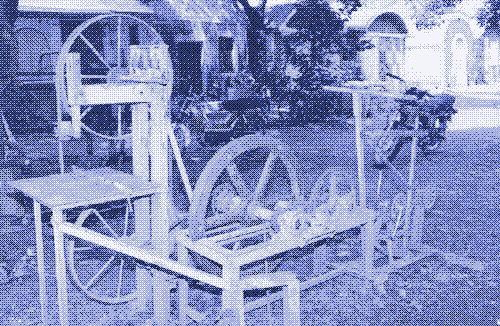
Human Powered Flywheel Motor
An interesting variation on the multi-purpose pedal powered machine is the Human Powered Flywheel Motor (pdf) designed by J.P. Modak, an emeritus engineering professor from India. The remarkable feature of Modak’s machine - which has been developed since 1979 - is that it can deliver much more power than the human who operates it.
The human powered flywheel motor can deliver much more power than the person who operates it
The machine system uses human energy and stores it in a flywheel at an energy-input rate convenient to the pedaller. After storing the maximum possible energy in the flywheel (pedalling time is 1 to 2 minutes), it is made available for the actuation of the process unit by the rapid release of the stored kinetic energy in the flywheel via a suitable clutch. The concept only works when the process can be of intermittent nature without affecting the end product.
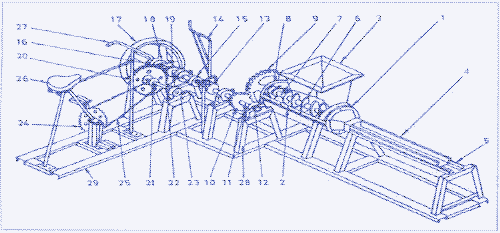
The human powered flywheel motor was initially developed for the making of bricks for a housing authority in Mumbai, India. Since then, it has been successfully used for several rural-based production activities such as water lifting, algae formation processing, wood turning, winnowing, wood strip cutting, electricity generation and the operation of a smiths hammer.
Processes needing up to 6 HP could be energised by the machine concept (although only one third of this has been achieved to date). This would be about 20 to 60 times more than what an average human can sustain either momentarily (300 watts) or for long periods (100 watts).
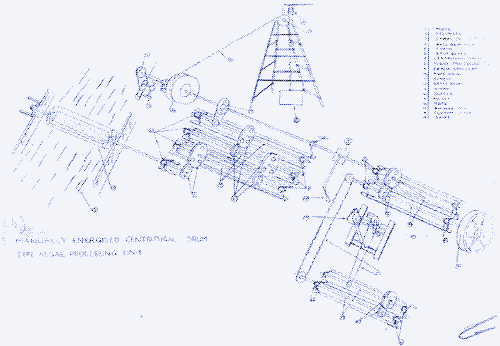
The energy unit consists of an existing bicycle frame which provides a seat and handle, a pair of speed-increasing gears, and a flywheel of about one metre in diameter. The transmission consists of a spiral clutch and a torque-amplification gear pair. For brick manufacturing in particular, the process unit consists of an auger, cone and die, conventionally used for motorized brick-extruders for the manufacture of clay bricks.
Combining Stationary and Mobile Pedal Power
A very different approach to multi-purpose pedal powered machines was followed by David Weightman. His concept (and prototype) was inspired by the Dynapod, but Weightman added one feature: the machine should still be usable for transportation. His Pedal Power Unit (PPU) was comprised of a bicycle wheel in forks fitted to a frame with a saddle.
The unit could then be used independently to drive machinery via a power takeoff but could also be connected to a two-wheel chassis to form a load-carrying tricycle. Furthermore, the unit could be connected in series with other units for machine applications requiring more power. Weightman justified his concept by emphasising the close link between transport and machine use in agricultural and industrial production:
“In a typical agricultural growing cycle, seed and fertilizer are transported to the field, crops are grown and then processed by machinery, and then produce is transported to the market. Similar patterns can be seen in construction and small scale industrial production. The use of a pedal power unit in this dual purpose role is exactly analagous to the use of tractors in European agriculture as power sources and transport devices. The PPU is equally suitable as the Dynapod when operating a number of machines but is more economically feasible for an individual farmer due to its capability as a transport device.”
The Dual-Purpose Bicycle looks very similar to the electricity generators which are sold today, though it is aimed at mechanically driving multiple machines and producing electricity
Job Ebenezer from the MGO ‘Technology for the Poor’ further developed this design, simplifying it greatly by substituting the tricycle for a bicycle. At first sight, his ‘Dual-Purpose Bicycle’ looks very similar to the electricity generating units which are sold today, though it is aimed at mechanically driving multiple machines and producing electricity.
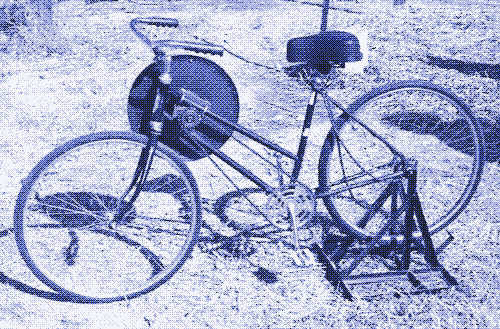
The ingenious design, primarily for agricultural use, consists of a very small flywheel attached to a standard bicycle, which permits its use as a pedal-powered machine that can be utilized to power numerous small-scale mechanical devices such as grain threshers, grinders, winnowers, peanut shellers, corn shellers, circular saws, wood working lathes, water pumps, electrical generators, and a variety of small tools.
The contraption can be converted from the transportation mode to pedal power mode in a matter of minutes. The broad stand, which provides stability during power production, can be flipped upward during the transport mode and doubles up as a freight carrier. The power-generating device remains attached to the bicycle in transportation mode, so that it can be easily transported and used immediately. Of course, this pedal power unit is a compromise, but it is an interesting one.
Contrary to modern concepts, it has a small flywheel and it does not use a friction drive because of its low efficiency. During the prime-mover mode, the bike’s regular chain is slipped off of the chain-wheel, and a custom chain to the power take-off mechanism is slipped on. Changing gear ratios is as simple as it is on a road bike. For driving more powerful devices, a larger flywheel can be placed between the power module and the process unit.

Treadles
The many advantages of pedal powered machines don’t make hand cranks or treadles obsolete. Not all devices need the extra torque of pedal power. Hand cranks and treadles can be a better option if power requirements are low or if power is only needed over a short period. A hand cranked device is much more compact than a pedal powered device. If hand control is required while operating low power equipment, treadles remain the best choice because they offer the operator more freedom of movement than pedals.
Of course, both mechanisms can also benefit from advantages in modern design and materials - including speed or torque increasing gears. A good example is the R2B2 kitchen unit by German designer Christoph Thetard (which is not for sale, unfortunately). It combines three kitchen appliances with a central driving unit. The heart of the unit is a treadle powered flywheel which works as an short-term energy storage (as in the Human Powered Flywheel Motor), capable of delivering up to 350 watts (of mechanical power) to the appliances. Similar to late 19th century machines, and contrary to today’s kitchen devices, it is built to last.
Lowering the Costs and Energy Losses of Pedal Powered Electricity
Many modern machines and devices cannot be powered directly by mechanical energy. This is especially true for electronic equipment (such as computers, cell phones, televisions, routers, etc.) but it is also true for refrigerators and light bulbs. If we want to keep these modern comforts, we have to find a way to make pedal powered electricity more efficient. There are several ways to do this.
1. Build a Generator from Scratch
The best way to start is to build a pedal generator from scratch instead of using a bicycle on a training stand. This allows you to replace the friction drive by a more efficient drive, like a chain drive, and to add a flywheel.
Steel flywheels can be found on the most expensive exercise bicycles. However, a flywheel can also be cheap, low-tech and just as efficient when you are using a bicycle wheel filled with concrete or a wooden tabletop. The latter is used by the ‘Pedal Powered Prime Mover’ (PPPM) made by David Butcher, which is one of the few good examples of a pedal powered electricity generator built from scratch (the plans sell for $50 and the cost for the DIY version is estimated at $230). It consists of a steel frame made of steel shelving supports.
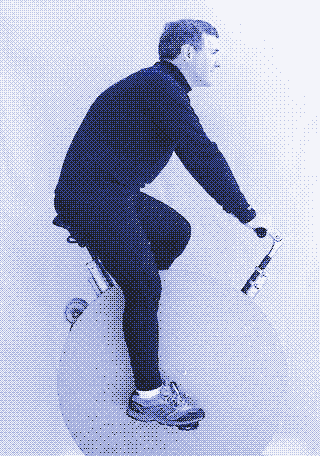
Although the PPPM uses a friction drive, it is a rather efficient one because it is basically powered by a wooden tyre - the flywheel. Since higher tyre pressure increases the efficiency of a friction drive, a wooden wheel can be considered a bicycle wheel with optimal tyre pressure. Furthermore, the flywheel is powered directly by the pedals, eliminating the energy loss in chains and sprockets altogether (it is a ‘direct drive’ in other words). The only drawback of this method is that you can’t change the gear ratio.
Butcher (who built his first machine in the seventies) claims an improved efficiency of 25 to 50% compared to a standard bicycle on a training stand. Interestingly, it can also power some devices via a direct mechanical connection: a water pump, a hammer, a masonry chisel, an air compressor and a hack saw. Building a pedal powered machine from scratch can thus offer you the best of both worlds.
2. Ditch the Electronics
You can go much further in order to improve the efficiency of a pedal powered generator. In the most extreme case, you could skip the voltage regulator, the converter and the battery, which leaves you only with the energy loss of the generator. Or you can leave out either one of these devices.
However, all these actions come with a price. If you do away with the converter, you need to replace the electrical devices you use. What you need, then, are DC-appliances like the ones you can plug in the interior of your car. While this can be an interesting option because of the high efficiency loss of a converter (25%), not all appliances come in a DC-variant.
In the most extreme case, you could skip the voltage regulator, the converter and the battery, which leaves you only with the energy loss of the generator
If you do away with the voltage regulator - and several of the pedal powered generators come without them - you have to carefully watch a multimeter while pedalling to make sure that the voltage does not exceed the capacity of the battery (or the device you are powering if you do away with the battery too).
If not, you could destroy the battery (or the device, if you don’t use a battery). A flywheel can be of great help here, because it smooths out not only the energy input (the alternating high and low force of a natural pedalling rhythm) but also the energy output, keeping the voltage relatively constant.
3. Get rid of the Battery
Doing away with the battery, or replacing it with a much more efficient and robust ultracapacitator, is probably the most rewarding thing you can do, not just in terms of efficiency, but also in terms of costs, reliability and - especially - sustainability. (Capacitators have a much longer service life than batteries, but a much lower energy density). However, you lose the advantage of generating energy and storing it for later use. In this case, you would have to pedal while using the device at the same time, as is the case with direct mechanical power transmission.
Whether or not this is convenient is dependent on what you want to use your generator for. If you mainly want to charge your laptop or cell phone, not having a battery to store the electricity isn’t a problem since the devices themselves have a battery. However, if you want to light the staircase room or power a television, desktop computer, electric guitar or small fridge, this becomes rather awkward. If you want to play recorded music and dance, not using a battery would also be difficult.
Update: In 2022 Low-tech Magazine made a bike generator with a control panel that addresses all these issues.
4. Build Large-scale Pedal Power Plants
Improving the efficiency of pedal powered electricity generation becomes easier as you organise it on a larger scale. In most of the arts and education projects described earlier, like the BBC program or pedal powered concerts, no batteries are used. The key here is that it is not one person both generating and consuming power, but a large group of people, of whom some are producing electricity whilst others are consuming it.
Pedal powered electricity plants could be a valuable backup solution to intermittent renewable energy sources
In a similar fashion, electricity could be generated in large pedal powered electricity plants, and then distributed to houses, shops, public spaces and factories. This is more efficient than doing it in each house separately because you can do away with the batteries and still offer electricity 24 hours a day. Power plants would simply add more pedallers when demand is high (such as during peaks hours) and send them home when demand is low (at night, for instance).
Human powered electricity plants should avoid the transmission losses of today’s extremely centralized power network. They should preferably be located in every neighbourhood or city district. In this scenario, it also becomes possible to do away with converters and switch the electricity distribution system from AC to DC, since the former was only chosen because it is more efficient to transport electricity over large distances. Of course, this is less plausible, since it means rewiring cities and replacing all devices.
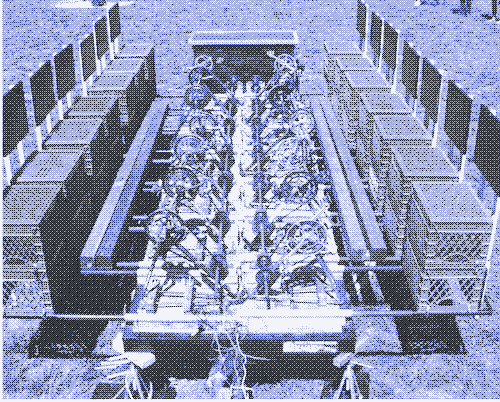
The Future of Pedal Powered Machines
If we boost the research on pedal powered technology - trying to make up for seven decades of lost opportunities - and steer it in the right direction, pedals and cranks could make an important contribution to running a post-carbon society that maintains many of the comforts of a modern life. The possibilities of pedal power therefore largely exceed the use of the bicycle.
Pedallers could power agriculture, factories, construction, mining and even other means of transportation than bicycles: aerial ropeways, cable trains and trolleyboats. Pedal powered electricity plants could be a valuable backup solution to intermittent renewable energy sources, replacing coal, gas and nuclear as a base load power for when the sun and wind let us down.
Human power is available 24 hours per day, is not affected by changes in the weather, is portable and can easily be stored for later use. Contrary to wind and biomass, it is an energy source that will never be depleted, since its potential keeps pace with population growth. Pedal power would also aid unemployment, leave us with a fit and healthy workforce, and produce a great deal of nice-looking bottoms.
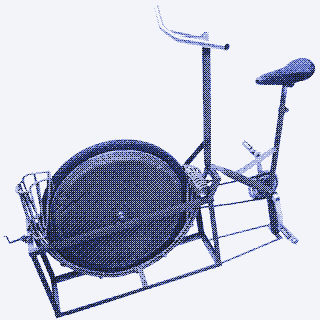
The Limits of Pedal Power
Of course, pedal power can only make a difference if we drastically reduce energy consumption. While athletes can produce a power output of over 2,000 watts on a bicycle, they can only sustain this over a period of a few seconds. The power that can be delivered by the average person over a sustained period of time is much less impressive than that: 75 watts or 1 “hup”. This unit of measurement (short for human power) was proposed in 1984, and tells us that an average person can sustain one hup for all day, 2 hups (150 watts) for roughly two hours, 3 hups (225 watts) for about 30 minutes and 4 hups (300 watts) only momentarily.
The absence of self-produced cooling winds results in possible overheating of the body
Another reason not to be overly-optimistic about the energy output of stationary pedalling is the fact that a stationary pedaller does not need to overcome air resistance. This sounds like a good thing, because at higher speeds a cyclist spends most of his energy compensating for air resistance. However, air resistance also keeps the active human body from overheating.
It was found that the power output measured by ergometers (stationary bikes used to measure the power output of cyclists) is substantially lower than that produced by the same persons on the road because the absence of self-produced cooling winds, which results in possible overheating of the body (this is also a problem with velomobiles). A (self-propelled) fan could keep the stationary pedaller cool, but it is only a partial solution. As David Wilson notes in ‘Bicycling Science’:
“The relative air flow generated by cycling is of such magnitude that it bears little resemblance to the drafts produced by the small electric fans often used for cooling people pedalling ergometers. At a speed of about 9m/s about 150 watts are dissipated into the air. Even if cooling fans of this power level were used [negating the power production by the pedaller, kdd], the cooling effect would be much less than that for the moving cyclist, because most of the fan power is dissipated as air friction in areas other than around the subject’s body.”
While body heat production might provide interesting side-effects in winter – you and even other people in a small room would not need heating – it would definitely limit the energy that can be delivered by pedal power. Pedalling outside when it’s windy may help, but this is not always possible.
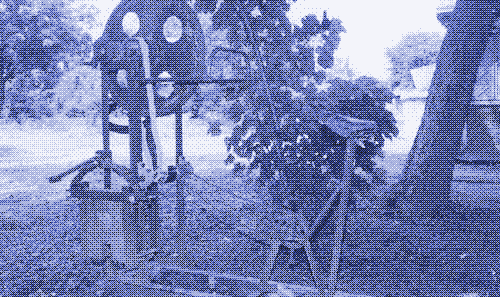
Wanted: 1.2 billion Pedallers for the UK
The main problem, however, lies in the demand for pedallers. To give you an idea, let’s see how many people would be needed in order to use pedal power at a base load power plant. An average UK family consumes about 13 kWh of electricity per day (an American family would consume at least twice as much).
If we consider a relatively small energy loss of 25% when converting human power to electricity, it would take 173 hours of pedalling at 100 watts (thus over one ‘hup’) in order to produce 75 Wh per hour. If we presume an electricity consumption that is evenly distributed over the course of 16 hours and no electricity consumption at night, this would take two shifts of ten people each pedalling non-stop for eight hours. And this concerns only residential electricity use.
If we consider total electricity consumption in the UK, each person needs 15.7 kWh per day, or two teams of ten people each pedalling non-stop for 8 hours. The UK would have to import a workforce of 1.2 billion people (a number equal to all the inhabitants of India) to pedal its way into energy independence, and prohibit all these people from using electricity themselves.
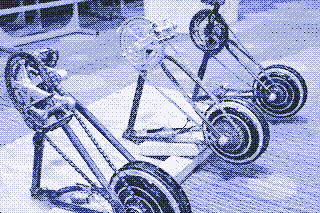
Here we are not even considering peaks in demand, but average consumption. And we are talking only about electricity consumption, not heating and transportation fuels. Of course wind and solar could help to diminish the need for base load pedal power. But when there is no sun or no wind, the power would have to be supplemented.
On the Other Hand/Foot
In other parts of the world, things are slightly different. If all Nepalese people could pedal two hours per day, the country would be entirely pedal powered, even without the support of other renewables. Interestingly, the NGO Ecosystems Nepal distributes pedal powered generators to Nepalese villages where they are used in a scenario somewhat similar to the one envisioned above. A village is equipped with one pedal power generator, which is pedalled for eight hours per day, charging large batteries.
The main problem with our approach to pedal powered machines is that we compare them to fossil fuel powered machines and not to the inefficient human powered tools and machines that went before them.
This village ‘power plant’ is then visited by the people living in the countryside in the surroundings of the village, who pass by once a month or so to charge their small motorcycle batteries. Even taking into account the considerable energy losses (in using batteries to charge batteries) one pedal generator provides enough electricity for 200 homes. This is possible because small batteries only need to power 0.2 watt led-lamps, enough to read a book. I am afraid that even my Kindle uses more than that, and it has no reading light.
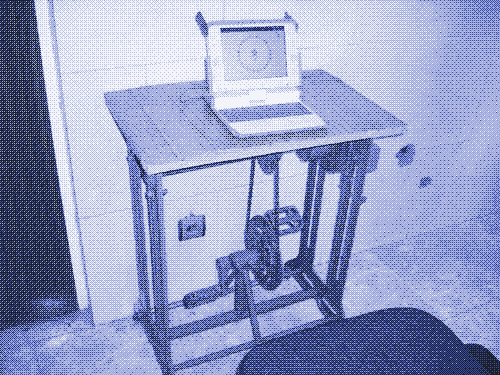
Cranks and pedals are not a solution at all if we decide to cling to an energy-intensive lifestyle - but then, neither is any other renewable (or even non-renewable) energy source. The main problem with our approach to pedal powered machines is that we compare them to fossil fuel powered machines and not to the inefficient human powered tools and machines that went before them.
This explains why pedal power is often laughed at in the western world but enthusiastically welcomed in the developing world, where, for instance, methods of agriculture still rely heavily on the use of human power using primitive tools which are usually inefficient. This is a scenario in which light is produced by dirty and inefficient kerosine lamps, or where there is no light at all.
Ironically, communities in the poorest countries in the world are developing into sustainable societies independent of fossil fuels, enjoying basic but modern comforts, while we continue to be ever more dependent on increasingly dirty, dangerous and diminishing energy sources.
Sources (in order of importance)
- “Pedal Power in Work, Leisure and Transportation”, edited by James McCullagh, Rodale Press, 1977. Still the best resource on pedal powered machines. - “The Human-Powered Home: Choosing Muscles Over Motors”, Tamara Dean, New Society Publishers, 2008. Very good book on human powered machines, both hand and foot powered. Includes half a dozen plans to convert bicycles into stationary pedal powered machines. - “Bicycling Science”, Third Edition, David Gordon Wilson, 2004
- “The Dynapod: a pedal power unit” (pdf), Alex Weir, 1980. More here. - “The use of pedal power for agriculture and transport in developing countries” (pdf), David Weightman, Lanchester Polytechnic, 1976
- “Design of a human-powered utility vehicle for developing communities”, Timothy J. Cyders, 2008
- “Supplement, Energy for rural development”, National Research Council, 1981
- “Tales from the Blue Ox”, Dan Brett, 2003
- “Bicycles and tricycles”, Archibald Sharp, 1896
- “In search of the massless flywheel” (pdf), John S. Allen, Human Power (Fall/Winter 1991-1992)
- “Design and development of a human-powered machine for the manufacture of lime-flyash-sand bricks”, J.P.Modak & S.D.Moghe, Human Power (Spring 1998)
- “Human Powered Flywheel Motor: concept, design, dynamics and applications”, J.P.Modak, 2007
- “Modern mechanism: exhibiting the latest progress in machines, motors, and the transmission of power”, Benjamin Park, 1892
- “Make electricity while you exercise”, Mother Earth News, 2008
- “Luther’s tool grinders” (pdf, 5.8 MB), hand and foot powered grinders catalog. Hosted at Toolemera Blog. - “Woodworkers’ tools and machines” (pdf, 29 MB), product catalogue no.25, 1884, Richard Melhuish Ltd., Tool and Machine Merchants, London. Hosted at Toolemera Blog. - “Science & civilisation in China, Vol.5, Part 9”, Joseph Needham, 1988
Reactions
To make a comment, please send an e-mail to solar (at) lowtechmagazine (dot) com. Your e-mail address is not used for other purposes, and will be deleted after the comment is published. If you don’t want your real name to be published, sign the e-mail with the name you want to appear.
Reactions
Mehul Kamdar
Some very interesting ideas - I think a modular system that combines a food processor, clothes washing drum and a battery charger would be an excellent product for many people. You could pedal away while watching television and get work done as well, while saving on electricity costs and burning calories. There’s something waiting for an entrepreneur to make a success of . . .
w.r.parker
hi Kris -
Very nice treatise on a niche subject . . i can humbly suggest one
more direct - driven arrangement at www.juicycle.com - the "
adult-height, arms-reach, multi-kitchen tool prime-mover device" -
developed in California. Although ‘wheat grass’ juicing is the format,
the typical hand-cranked, kitchen appliance is a low-tech,
“plain bearing” system, and usually iron-on-iron surfaces.
These bearings do not wear especially well when driven from a single
vector, like in the chain-drive illustrated on your page. . . hence
the “steel finger” drive of the type described as ‘juicycle’ .
. leg-powered, imitating a hand-cranking motion . . low tech
with ‘clutching-and-breakaway’ safety features are included . . plans available there.
thanks,
wrparker
Peter Silva
When discussing use of DC power to avoid losses due to added electronics needed, the article states ‘’there are no DC-laptops’’ for example.
The opposite is true, there are no AC laptops. Invariably, there is a power brick/transformer which converts residential AC (220 or 110) into DC, between 14 and 18 VDC, depending on the laptop model. So one merely needs to now the output voltage of the power brick to determine how to feed a laptop.
Kris De Decker
@ Ron:
Great idea. I think you are referring to this “gravity-powered” system:
http://www.notechmagazine.com/2013/01/how-to-design-more-powerful-gravity-powered-lights.html
KJMClark
Drat! Peter beat me to the punch! I’ve never seen an AC laptop. For that matter, I’ve never seen an AC desktop computer. In both cases, the AC has to be converted to DC to operate the device. It seems like there aren’t many devices that work better with AC power. Just about everything takes the AC and converts it back to DC for operation. I think there are some motors that are designed to run on direct AC - fans come to mind, maybe compressors. It pretty much has to be something that can run at a constant speed, since the AC current alternates at a stable 60Hz.
matthias
With todays cost of photovoltaics it makes more sense to build solar power than pedal power.
Wiring a small house with DC is possible and done sometimes like for camping or on boats. There are 12V tools or adapters for everything needed in a household.
Today AC is used because it is easy to transform. If the Voltage is doubled there is only half of the current for the same power. Thus wires can be thinner and transmission losses can be reduced. Long time was not possible to transform one DC voltage to another. So a motor generator set has to be used. With todays electronically DC/DC converters the grid could be built with DC.
On the other side a pedal powered generator could produce 230V AV directly using an asynchronous generator. the transmission and pole number of the generator would have to be set so that a convenient and efficient pedal speed can be achieved .
Juliano Pappalardo
I and some friends are reading this usefull post we intend to build something, thanks from Brazil :)
Seth
Is a DC generator the best way to link up multiple pedalers or can they be combined to power one machine mechanically without the loss of electric energy transfer?
John Trask
I think that there are simpler and more energy efficient tools at least for splitting wood, namely axes, mauls, and wedges.
Sandpine
Splitting wood using pedal power may not be the best use of the technology BUT you don’t need an adult to do the pedaling. The wood splitting chores could be relegated to children/youth leaving adults free for other tasks.
Tim M
“Human power is available 24 hours per day, is not affected by changes in the weather”
Let’s test this. Come down here to South Texas, first in January, and measure how much pedal power you can produce in an hour. Then, come back in August and re-perform the test. I think you’ll find that the weather will have indeed affected your power output (as well as your health).
clarence hale
hi-
from a commentator over at http://thearchdruidreport.blogspot.com/2011/06/profligacies-of-scale.html came the referral to an online pdf for pedal power in work, leisure and transportation at http://www.zetatalk3.com/docs/Pedal_Power/Pedal_Power_In_Work_Leisure_And_Transportation_1977.pdf the scan is only of medium quality but sufficient for reading. some of the illustrations and pictures did not scan well.thought this would be of interest to your readers.
clarence
Seven
I would LOVE to see someone incorporate a Fresnel lens to boil water then attach that motion to the pedals and viola a sun powered bike…a sun tracker could be used to get continuous power. Alas I have neither the time or resources to persue.
Tyler August
Seth: I’m no mechanic, but I suspect something equivalent to the differential gear in your car (driven backwards, pedal power to the wheels) would serve to join two slightly-off rotary sources. I’m almost certain you could rig something up; or you might find for your application a hydraulic transmission system works better; depending on what’s doing you can get lower losses than electric that way. (and, again, depending what you’re doing and what resources you have, it can be easier to home-brew)
Kris:
After reading this post, I went looking for “Pedal Power for Work and Transportation” in the local library– and found a wealth of 70s era ‘appropriate tech’ resources. Our library is awesome and I thank you for helping me realise that.
Scott
Found another great example of modern pedal power being put to good use: http://blog.makezine.com/archive/2011/12/mobile-sharpening-rig.html
Philip DeVerna
Very interesting article. I am doing a paper for school and was wondering; everything I have been reading on bicycle generators always involve a stationary bike. Does anyone know if there is a generator that one could us while using the bicycle in its normal capacity? Thanks a lot
drs
Look at the thermodynamics: a human is a heat engine converting biomass (high quality food) to work at maybe 25% efficiency, which is then used to pedal and drive machinery or batteries.
Conversely, a steam engine can burn biomass (anything) (or take heat from solar, geothermal, or storage), at 20-33% efficiency (depending on size, bigger’s usually better) to then drive machinery or make electricity.
The steam engine/power plant takes more capital, whereas humans come with society. OTOH it’s a lot less picky and takes less labor.
1.2 billion pedallers – yeah, sounds about right. Another approach is to look at power usage (10 kW for the average American, counting all domestic power use), which at 100 Watts per person is like having 100 mechanical slaves per person.
ken hargesheimer
All computers, internally, operate on 12 v. They can be alternated very easily to by pass AC and operate directly on 12 v. Use a solar panel to charge the battery if necessary. free info at minifarms@gmail.com
nick hein
We’ve built and refined a simple pedal generator that can be built entirely from salvaged materials in about 30minutes, and will provide plug-in power to any 120VAC appliance that can run on DC as well. By testing we have found that this includes TVs, lights, power tools, water pumps, vacuum cleaners, blenders. I’ve got a picture at this link:
http://PublicFiles/PedalGenerator/2009_1010_RollerGenerator.jpg
A 120VDC motor from a discarded treadmill is mounted to a piece of channel that is bolted to a bike training stand, in place of the resistance unit. All that was necessary was to drill the motor mount to the channel, and the channel to mound to the stand. If you leave the flywheel on the motor you’ll only get about 30V, we used a holesaw to cut the center out of the flywheel and turn it down to make a 2" dia roller which gives us about 120V when driven by a 27"/700C bike wheel. The motor can be wired directly to an outlet and regular appliances plugged in. We haven’t blown or burned anything up yet, and we’ve tried quite a few things. The advantage of this approach is it’s quick, and doesn’t require any modification of the bike or the appliance that you plug in to. I built this one myself using only a drill press in 30 minutes. (A friend later made the roller with a holesaw and small lathe.)
marcos bendrao
Is it possible to generate electrical power in a sustainable and efficient way on a “mobile” bike (as opposed to a fixed one that I see on the pictures)? It’s probably a very basic question but I’d really appreciate any insights you might want to share. please feel free to email me: marcos.bendrao@gmail.com.
thanks!
Johnny Payphone
Thank you, thank you, THANK YOU for your “ditch the battery” stance! This cursed box of poison will be the undoing of the “green” movement. The inefficiency compared to a “mechanical battery” or flywheel is simply unacceptable. The disposal issues are a nightmare!
I have been developing a “human capacitor” along three paths: Flywheel, compressed air, and springs. In each case waste energy (bicycle braking) is the energy source. Anyone who has ever tried to light a light-bulb with an exercise bike knows that human energy output compared to consumption is pitiful…. when thought of only in terms of electricity!
David Mac
Just a thought, A big tank on an elevated platform, a little hydraulic ingenuity and all these machines will work (Water motors are well researched) a pedal powered pump (and a windmill) to fill the tank. Pedal when you want, use the energy when you want. Very low loss systems. Not a new idea, just a little forgotten.
CanofSol'n
Hey People!
Listen, coming from someone who knows a LOT about motors: If you wish to generate electricity with your pedal-powered prime mover, then DO consider that ugly, HEAVY, bulletproof, 10+HP AC compressor motor that the out-of-business company down the road abandoned as your generator..
You can Quite easily rectify its output into DC with the use of suitable diodes. This also means that by monitoring a voltmeter whilst you pedal, you can pretty much CHOOSE the voltage that you want (12 / 24 / 36VDC) without driving the motor to its nameplate speed.
Industrial diodes do have a larger voltage drop, but you can easily find them used and in ample supply.
It is actually common in the electrical / engineering trade to rectify 347/600VAC power supplies with these semiconductors – and we DO.
Good on us – stick a PLUG in their dirty oil pipe.
Amasa
Question… I am working on a project that includes a bike with a grain milling attachment on it (actually used for grinding coffee). Also, I would like for the bike to be able to heat water, fairly efficiently if possible. Does anyone have any relevant ideas or links to contribute? It could use mechanical energy but I am also considering other “sustainable” options. Thanks!
Lou
What are your thoughts about a Pedal Powered PTO? A video and website with more information.
http://wellwaterboy.com/id87.html
http://www.youtube.com/watch?v=EMtFlmFqWTs
Seems it can just run anything with a shaft. Something new for this day and era?
Jerry Friedman
Many of the comments about bicycling were false. While aerodynamics are critical to bike speed the seat tube angle is critical to generating power with your legs. If you sit further back from the crank center you can’t ‘spin’ the pedals very fast which limits the HP and increases the torque. Conversely most racing bikes have steeper angles which allow less pressure to be applied to pedals spinning much faster.
If you push very hard at a slow rate your legs will go into ‘oxygen debt’ and become useless quite soon - ‘Spinning’ at a rate of 92 beats per second allows your cardiovascular system to come into play and sustain much, much longer periods of work. Sitting back too far and pushing too hard will cause harm to your knees as well.
Bicyclists learn to ‘spin’ in a circular motion which brings more muscles into the game.
Flywheel systems and water transfer energy systems employ sustained small efforts to develop usable large forces - So correctly designing the ‘user interface’ would make the difference between a workable system and a novelty (that has potential heath risks).
Many of the designs shown (seats of plastic milk crates?) don’t look practical at all from a peddler’s perspective.
Many seem to put the peddler at a mechanical disadvantage even as he sits on the thing…
tom foxe
While much of the comment is factual, these criticisms of pedal-powered generation are too negative for me. They fail to recognise that pedal-power generation releases us from the tyranny of centralisation. Activities such as music concerts and cinemas don’t have to depend on the national grid and commercial cinema chains,and they can be done cheaply so the admission price is low.
OK, it IS more efficient to operate machines wihtout electricity if it can be done, but this doesn’t mean that bicycle-powered generation isn’t worthwhile.
It would have been educational to show the BEST examples of pedal-powered generation, with a headline like “How to get the most out of pedal-powered generation”
Please encourage good work, don’t trash it.
Katherine P
Thank you very much for this article, which has moved my ideas on radically from “I wish I could power my PC with cycling while sitting at it”.
I totally support Mehul Kamdar’s comment right at the top. The spin cycle on a washing machine is crying out for a connection to flywheel-stored energy, eg as generated by Job Ebenezer’s dual-purpose bike (which I think answers Marcos Bendrao’s comment 25) - I love the flipped carrier/stand too, btw.
And there’s lots of idle time in front of the TV or computer (we’d need new, higher & deeper, desks for the latter, of course) to generate it. Plus plenty of recent research on how damaging all that sitting around is for our health.
Come on, entrepreneurs, please build it!
Dee
This was really helpful. Having decided to acquire an exercise bike (for fitness) I was really into the idea of using my energy to power something. Since I don’t use mechanical tools (and I don’t make smoothies) I would have gone for the rather pointless battery stuff - and I’d never have been able to generate the embedded energy in the kit. I am hopeless at DIY and not very fit so now I’ll just concentrate on the health benefits (and reducing my energy use). Dee
Ron Shook
Articles such as this tend to get my imagination juices flowing. While reading the comments I started thinking along the same lines as the commentor, David Mac, “A big tank on an elevated platform, a little hydraulic ingenuity and all these machines will work (Water motors are well researched) a pedal powered pump (and a windmill) to fill the tank. Pedal when you want, use the energy when you want.
My thoughts were even simpler. About a year or so ago there was an article about an invention for afterhours reading or work light for the developing world which was dirt simple, no battery, just a tiny mechanical generator and an LED bulb. It was powered by gravity. You simply hung it up, filled a bag with 20 lbs of rock or dirt, lifted the bag a couple of feet and had light for half an hour with each lift of the bag. They figured the cost for this device in scale quantity would be about $7. This sure seems like a lot simpler solution than the Nepalese example in this article or storing water up high for an electricity generating water turbine.
It sure seems like a scaled up version of this tech using a bike hooked to a block and tackle lifting a 500 lb to one ton weight up 5 or 6 feet would be a way to store and supply considerably more power for small electric or mechanical powered in-home industry.
Transfer this to the developed world and a multi-position exersize machine (think Bowflex), not just pedaling, could do the same thing. For example, exersize for half an hour and you’ve got enough energy stored to watch 2 hours of TV or whatever. Make use of Michael Pollen’s food and eating principle that you can eat as much junk and deep fried food as you want as long as you make it yourself and have to deal with the hassle and mess. In this case it’s watch as much TV as you want as long as you make the power to do it yourself.
braden godden
haven’t we already got potential human power plants? why can’t our existing gyms be converted so that, not only pedal power, but all the other activities like running, leg pulls & pushes, arm and rowing excercises all used to manufacture combined power to be added to the grid, every town , every city… excercise with a free power bonus! if its too difficiult to convert exising gyms… create new ones with incentives for super generators… just an idea bg
Tony
Found this website looking for kinetic sculpture ideas. I like the idea of gyms as a energy resource and would suggest taking it a little further having our countries jails setup this way. There seems to be a lot of human power there, that is not being put to good use.
jason
great article, and thanks to the author. reminds me of the Professor on Gilligan’s Island! tell Michelle Obama that the fight against obesity in America’s kids can be solved here: if kids want to watch TV, use the internet, or play video games for an hour, they have to pedal a stationary bike for 30 minutes.
thanks for the inspiration. i hope i can create something out of the suggestions here.
Greg Marlow
Peddle power is still a carbon based energy source. The carbohydrates and fats you eat are used to make the energy for your muscles and you finally exhale carbon dioxide gas.
Mario Juarez
La colección, de experiencias es muy buena, y en Maya Pedal estamos fecilices de proveer, bicimaquinasa personas, con interes en nuestra alternativa, dandoles soluciones viables, como independencia energetica, a su salud, y productividad.
sinceremente. Mario Juarez director Maya Pedal, www.mayapedal.org, https://www.facebook.com/MayaPedal
David Remus
A juicer, for example, is very high tech. Why not simply eat the vegetables and fruits, eliminating the need to expend energy building yet another truly useless machine? The best low tech idea often is to simply do as people did before electricity.
Imagine the extra water and energy needed to grow more food, ship it to the pedlaers, and feed people spending a lot of time exerting themselves to run machines we don’t really need. And yes, an army of slaves generating useful work pedaling makes it easier on the person not mindlessly pedaling. Slave owners knew that thousands of years ago.
Slowburn
@ (30) Amasa
To heat water by peddling power a heat pump with the peddling putting the condenser into the water tank. In hot climates a suit of tubes full of cold water can keep you cool and preheat the water for the boiler.
Archangel
All you need to do is hook your generating cycle into the grid. You will produce direct power that can be traded for power to your own home. This removes the battery issues. Most of the research was based on using a traditional bicycle to generate electricity. Manoj Bhargava with Free Electric/Billions in Change is marketing a bycycle designed to create electricity. By gearing the pedals to a weighted flywheel they have increased the electricity generation capability beyond that of a traditional bicycle. It’s easy to poke holes in failed attempts. We need to start thinking in terms of solutions and quit all the naysaying.
Oscar Nitz
If we could get our society to the point of energy efficiency where having shifts of people pedalling bikes is a viable alternative for power production then we may as well go back to using fossil fuels because we would use so little and it would become viable.
Byron Hale
There are DC laptops. Dell Computer has AC adapters, but they supply DC to the laptop.
Here, along the Cascadia Fault (effectively from California’s Golden Gate to Canada, or maybe Alaska, we will be needing low-tech solutions.
Formally from Cape Mendocino, heading North, the power grid is expected to be knocked out from San Francisco to Sacramento and West of Highway I5, stretching at least to Canada. The catch is that we don’t know when. The last time the fault blew was 1701, as evidenced by tsunami devastation in the State of Oregon and in Japan.
When this happens, we can expect no power to pump gasoline.
Keep the articles coming.